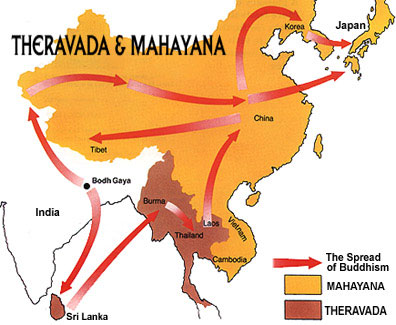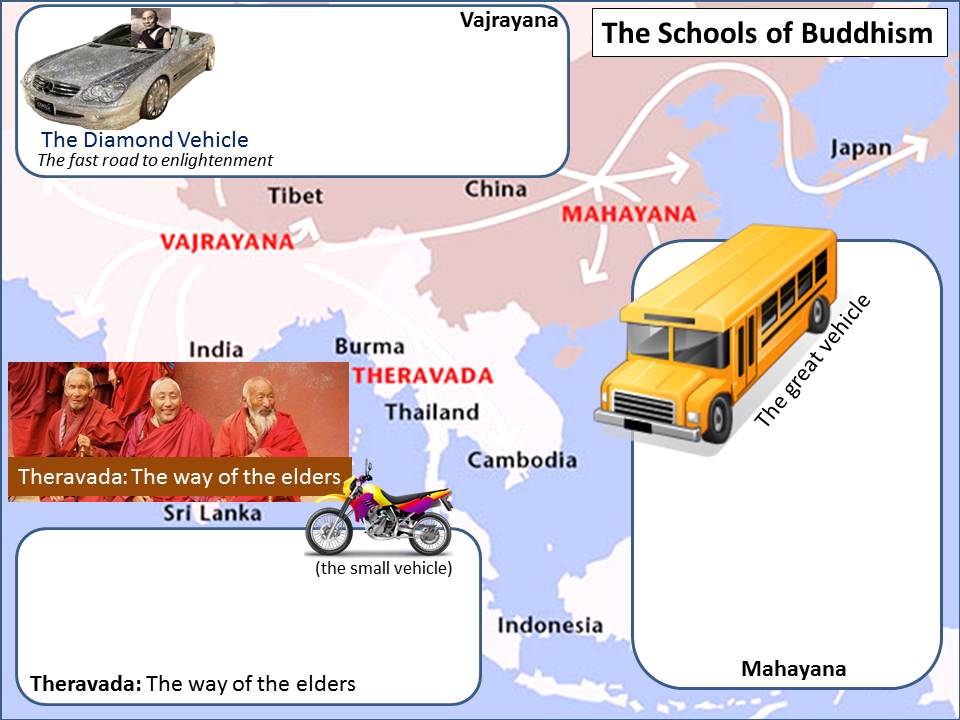|
The
Sangha Technically, a Sangha is a monastery - the monastic community. Buddha had initiated a community of monks (bikshus) and nuns (bikshunis) in settings conducive to meditation and pursuit of enlightenment. When one chooses to follow the monastic life, one enters the Sangha and takes monastic vows in pursuit of one’s own Buddhahood (anyone can become a Buddha as Siddhartha did. This is the ultimate goal of Buddhism - to become a Buddha is to enter Nirvana). Theoretically, we can extend the term Sangha to apply to various Buddhist groups (e.g., a Buddhist "church") and to the entire Buddhist community including both laity and monastics.
Historical development: Under the Indian king Ashoka in the third century BCE Buddhism caught on and spread beyond India. Ashoka was attracted to the new religion and sent out missionaries to convert non-Indians. Ashoka also encouraged a gathering of 500 "Elders" to compile the Buddha’s teachings into what became the basic scriptural texts: The Pali Cannon or Tripitaka ("Three Baskets"). The Buddha’s teachings were transmitted orally for several centuries until they were written down and stored in three baskets. Each collection consisted of a different kind of teaching:
These teachings were written in the Pali language, a dialect specifically designed for the purpose of transmitting the Buddha’s teachings. Ultimately, Buddhism died out in India (by around 1000 CE) but had, by then, become widespread in southern and eastern Asia. Buddhism varies greatly from one geographic area to another, having incorporated into itself (adopted and adapted) ideas and practices from religions of the lands it spread to. The
Spread of Buddhism Explore an interactive timeline of Buddhist history Three major divisions in Buddhism:
These are the "vehicles" which carry one along the path. The image of a raft is often alluded to. Various schools or sects are useful for getting one to the other shore (from Samsara to Nirvana, from ignorance to enlightenment) but once one has arrived, one should not be so attached to the vehicle that one does not move on leaving it behind. Theravada is more orthodox, more in keeping with the original teachings of the Buddha. It focuses on monastic life and meditation as a self-directed way to enlightenment. If Buddhism is a vehicle, this form is like a motorcycle in that each Buddhist is responsible for his or her own enlightenment. The majority of Buddhists are Mahayana and refer to Theravada as "Hinayana" ("Small Vehicle") thus Mahayana is "great" in size but also in thinking it is the more productive way to achieve Nirvana ("Hinayana" is considered a derogatory term and ought to be avoided). Like a bus, individual Buddhists are carried by enlightened ones (priests, ministers, monks, heavenly buddhas, etc.) Vajrayana is the ritualistic form of Buddhism in Tibet, incorporating practices from the ancient folk religion (Bon) of Tibet These are the "schools" of Buddhism (no, not a place you go to get an education. Here, by "school" we mean a philosophical "school of thought") Here's a chart contrasting Theravada and Mahayana Buddhism Use
this worksheet to
make your own notes about the distinctive features of each school:
|
| Created by Laura Ellen Shulman |
Last updated: February 22, 2013
|

